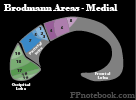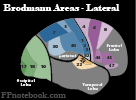II. Pathophysiology
- Images
- Results from CNS Disease affecting the dominant hemisphere
- In contrast, lesions in similar areas of the non-dominant hemisphere result in visual or auditory inattention
-
Broca's Speech Area (Brodmann Area 44 and 45)
- Lesions in this region of the dominant hemisphere result in Expressive Aphasia
-
Wernicke's Area (Brodmann Area 22)
- Lesions in this region of the dominant hemisphere result in Receptive Aphasia of spoken word
-
Angular Gyrus (Brodmann Area 39)
- Lesions in this area of the dominant hemisphere affect reading (alexia) and writing (agraphia)
III. Definitions
- Aphasia
- Communication disorder with impaired expression or comprehension of verbal and written language
- Expressive Aphasia (Broca Aphasia, Nonfluent Aphasia)
- Defect in expressing speech, writing or signs
- Receptive Aphasia (Wernicke's Aphasia)
- Defect in understanding speech or written word
IV. Testing
V. References
- Goldberg (2014) Clinical Physiology, Medmasters, Miami, p. 106-7


